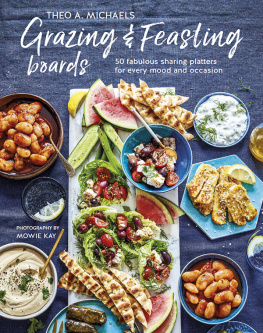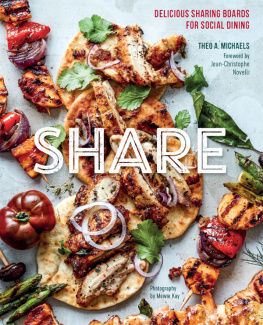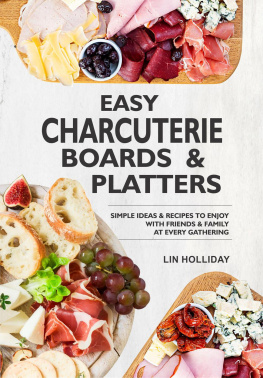Grazing & Feasting boards


THEO A. MICHAELS Grazing & Feasting boards 50 fabulous sharing platters for every mood and occasion PHOTOGRAPHY BY MOWIE KAY

Dedicated to my darling wife Anna and kids Eva, Lex and Luca. And the dog Belle, she hates being left out CREATIVE DIRECTOR Leslie Harrington EDITORIAL DIRECTOR Julia Charles EDITORS Gillian Haslam & Kate Eddison HEAD OF PRODUCTION Patricia Harrington FOOD STYLIST Kathy Kordalis PROP STYLIST Lauren Miller INDEXER Hilary Bird Published in 2022 by Ryland Peters & Small 2021 Jockeys Fields London WC1R 4BW and 341 E 116th St New York NY 10029 www.rylandpeters.com Text copyright Theo A. Michaels 2022 Design and photographs copyright Ryland Peters & Small 2022 ISBN: 978-1-78879-466-4 eISBN: 978-1-78879-487-9 10 9 8 7 6 5 4 3 2 1 The authors moral rights have been asserted. All rights reserved. No part of this publication may be reproduced, stored in a retrieval system, or transmitted in any form or by any means, electronic, mechanical, photocopying or otherwise, without the prior permission of the publisher.
Printed and bound in China. CIP data from the Library of Congress has been applied for. A CIP record for this book is available from the British Library. 
 NOTES Both British (metric) and American (imperial plus US cups) measurements are included in these recipes; however, it is important to work with one set of measurements and not alternate between the two within a recipe. Uncooked or partially cooked eggs should not be served to the very old, frail, young children, pregnant women or those with compromised immune systems. When a recipe calls for the grated zest of citrus fruit, buy unwaxed fruit and wash well before using.
NOTES Both British (metric) and American (imperial plus US cups) measurements are included in these recipes; however, it is important to work with one set of measurements and not alternate between the two within a recipe. Uncooked or partially cooked eggs should not be served to the very old, frail, young children, pregnant women or those with compromised immune systems. When a recipe calls for the grated zest of citrus fruit, buy unwaxed fruit and wash well before using.
If you can only find treated fruit, scrub well in warm soapy water before using. Always sterilize jars to be used for storing homemade preserves and sauces before use. See for instruction on ways you can do this. Food safety: ensure your serving board or platter is clean, food-safe and heat-proof if necessary before use. Rub wooden surfaces with olive oil to avoid staining and choose non-porous surfaces for oily or juicy foods. CONTENTS  INTRODUCTION In my role as an Executive Chef Ive been creating grazing experiences for many years now.
INTRODUCTION In my role as an Executive Chef Ive been creating grazing experiences for many years now.
These have ranged from intimate boards for two people to share by candlelight, to huge feasting tables for 250 plus corporate diners. This book is the culmination of all my experience to date, laid out and presented to you in one place. In the following pages youll find my blueprints for 50 themed grazing boards and sharing platters to suit every occasion, from a family night spent in front of the TV to effortless entertaining over drinks with friends, and ranging from the humble to the spectacular. Some offer outrageous fun, others sophisticated elegance. Each sharer is designed around a theme and Ive listed everything you need to recreate these beautiful edible works of art at home. I invite you to use the list of suggested ingredients as a guide (making any substitutions you like to suit your own tastes or audience), follow my simple recipes, or buy in ready-made versions for maximum convenience.
Then using the beautiful photographs as your main inspiration, with encouraging guidance and tips from me on the sidelines, build your boards with confidence and creativity. I couldnt resist including some of my favourite recipes, but I offer you these as suggestions only not rules so feel free to swap out ingredients, or combine elements from different boards to create something you love. Sharing food is one of lifes great pleasures, its something that I touch upon in almost every cookbook Ive created and something we try to do as a family as often as possible its good for the soul. The concept of breaking bread is thousands of years old and I, for one, believe it to be at the very heart of being human. Its eating together that cultivates our relationships with friends and family and gives us the platform to spend time together. My boards are the very definition of bringing people together and enable you to create shared memories over delicious food, spectacularly presented in a fun, interactive way.
HOW TO BUILD YOUR SHARERS CONSIDER YOUR BOARD CAREFULLY Over the years Ive used a variety of surfaces as boards. You cant beat a wooden chopping or bread board for a small sharer, or a piece of plywood for something larger. (If you rub olive oil into the wood this helps protect the surface from staining.) Trays are also useful, especially the butler style with a shallow lip and handles, which are most convenient for times when you may be casually snacking on the sofa, rather than a flat board, which works best when stationary on a table, as items may wobble and fall off. When you are including oily or juicy food, a non-porous surface like slate or ceramic works best. But as long as what you choose is clean, food-safe and heat-proof, if necessary, youre good to go! USE COLOUR EFFECTIVELY Consider colours carefully, from the surface of the board to the food itself. Use shades that work within your theme, from the board to the small dishes and serving tools.
Or, if your board is all one type of food, such as cheese, and seems a bit flat, take a step back and see where you could add bursts of colour to liven it up, either with small dishes of accompaniments or fresh garnishes, such as herbs. CREATE VISUAL ANCHORS Boards work best when they have a few visual anchors, by which I mean larger pieces of food (or in some cases it might be bowls of dips or sauces), that add structure and give definition. Always position these first and build the board up around them, remembering to consider whether your board will be seen from the front only or from all sides. POPULATE THE SPACE Once the big stuff is in place, you can start to fill the spaces in between. Also, remember to keep wet ingredients away from dry. Arrange overlapping lines of bread, crackers or cookies; these can also act as useful barriers between, say, cheese and cold meats, or savoury and sweet.
Next add clusters of any medium-sized foods. Odd numbers work best for visual displays so arrange things in clusters of three, five and so on. HOT STUFF Ensure food that is to be eaten hot is added last and build up your board in advance leaving a gap for it. I often put a swirl/smear of condiment on the surface as a placeholder for the hot item, then its good to go as soon as the hot stuff is added. MIND THE GAPS When the board starts to fill up, it is time to move on to the smallest items; placing a handful of olives, grapes or nuts into some of the gaps, or small bundles of radishes or salad leaves and so on. CONSIDER THE CONDIMENTS I often wipe and smear these straight onto my boards, but you can also place them in small ramekins and pots with spoons.
Position them conveniently close to the foods they pair with, so cheese next to chutney, ham next to mustard. ADD FINAL FLOURISHES Use sprigs of fresh herbs, citrus slices and wedges and edible flowers and dot about to add colour and freshness. Adding a drizzle can be a nice touch too, to add flavour as well as visual interest: balsamic glaze, flavoured oils, sweet syrups and sauces can all work. Keep all the garnishes edible to avoid possible confusion and/or food poisoning! 










 THEO A. MICHAELS Grazing & Feasting boards 50 fabulous sharing platters for every mood and occasion PHOTOGRAPHY BY MOWIE KAY
THEO A. MICHAELS Grazing & Feasting boards 50 fabulous sharing platters for every mood and occasion PHOTOGRAPHY BY MOWIE KAY  Dedicated to my darling wife Anna and kids Eva, Lex and Luca. And the dog Belle, she hates being left out CREATIVE DIRECTOR Leslie Harrington EDITORIAL DIRECTOR Julia Charles EDITORS Gillian Haslam & Kate Eddison HEAD OF PRODUCTION Patricia Harrington FOOD STYLIST Kathy Kordalis PROP STYLIST Lauren Miller INDEXER Hilary Bird Published in 2022 by Ryland Peters & Small 2021 Jockeys Fields London WC1R 4BW and 341 E 116th St New York NY 10029 www.rylandpeters.com Text copyright Theo A. Michaels 2022 Design and photographs copyright Ryland Peters & Small 2022 ISBN: 978-1-78879-466-4 eISBN: 978-1-78879-487-9 10 9 8 7 6 5 4 3 2 1 The authors moral rights have been asserted. All rights reserved. No part of this publication may be reproduced, stored in a retrieval system, or transmitted in any form or by any means, electronic, mechanical, photocopying or otherwise, without the prior permission of the publisher.
Dedicated to my darling wife Anna and kids Eva, Lex and Luca. And the dog Belle, she hates being left out CREATIVE DIRECTOR Leslie Harrington EDITORIAL DIRECTOR Julia Charles EDITORS Gillian Haslam & Kate Eddison HEAD OF PRODUCTION Patricia Harrington FOOD STYLIST Kathy Kordalis PROP STYLIST Lauren Miller INDEXER Hilary Bird Published in 2022 by Ryland Peters & Small 2021 Jockeys Fields London WC1R 4BW and 341 E 116th St New York NY 10029 www.rylandpeters.com Text copyright Theo A. Michaels 2022 Design and photographs copyright Ryland Peters & Small 2022 ISBN: 978-1-78879-466-4 eISBN: 978-1-78879-487-9 10 9 8 7 6 5 4 3 2 1 The authors moral rights have been asserted. All rights reserved. No part of this publication may be reproduced, stored in a retrieval system, or transmitted in any form or by any means, electronic, mechanical, photocopying or otherwise, without the prior permission of the publisher. 
 NOTES Both British (metric) and American (imperial plus US cups) measurements are included in these recipes; however, it is important to work with one set of measurements and not alternate between the two within a recipe. Uncooked or partially cooked eggs should not be served to the very old, frail, young children, pregnant women or those with compromised immune systems. When a recipe calls for the grated zest of citrus fruit, buy unwaxed fruit and wash well before using.
NOTES Both British (metric) and American (imperial plus US cups) measurements are included in these recipes; however, it is important to work with one set of measurements and not alternate between the two within a recipe. Uncooked or partially cooked eggs should not be served to the very old, frail, young children, pregnant women or those with compromised immune systems. When a recipe calls for the grated zest of citrus fruit, buy unwaxed fruit and wash well before using. INTRODUCTION In my role as an Executive Chef Ive been creating grazing experiences for many years now.
INTRODUCTION In my role as an Executive Chef Ive been creating grazing experiences for many years now.